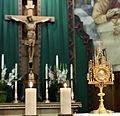Transubstantiation facts for kids
Transubstantiation is a special teaching in the Catholic Church and some other Christian churches. It says that during a church service called the Eucharist (or Mass), the bread and wine used actually change.
Even though the bread still looks, smells, and tastes like bread, and the wine still looks, smells, and tastes like wine, Christians who believe in transubstantiation believe they have truly become the body and blood of Jesus Christ. This happens after a priest says special prayers.
Contents
What Christians Believe About Transubstantiation
Christians who follow this teaching believe that when they eat the bread and drink the wine at Mass, they are truly receiving the body and blood of Jesus. They know it still seems like bread and wine to their senses. But they believe a miracle happens, and the real substance changes. The priest's prayers during the Mass are very important for this change to happen.
The Last Supper and Its Meaning
This belief comes from something Jesus did the night before he died. He shared a special meal with his friends, which is now known as the Last Supper. During this meal, Jesus took bread and said it was his body. He also took a cup of wine and said it was his blood.
In the Gospel of Matthew, chapter 26, it says:
- Verse 26: "Take this [bread] all of you and eat it. This is my body which will be given up for you." This means Jesus would die for them.
- Verse 27: Jesus then said, "Take this [cup] all of you and drink from it. This is the cup of my blood, the blood of the new and everlasting covenant." This means his blood would create a lasting promise between God and people.
- He also said, "My blood will be shed for you and for all so that sins may be forgiven." This means Jesus would die so that people's sins, or wrongdoings, could be forgiven.
- Finally, Jesus told them, "Do this in memory of me." This was a command for his followers to continue this special meal.
Since that time, Christians have continued to celebrate this meal. It reminds them of Jesus and the Last Supper.
Related pages
Images for kids
-
Transubstantiation – the real presence of Jesus in the Eucharistic Adoration at Saint Thomas Aquinas Cathedral in Reno, Nevada
-
A 3rd-century fresco in the Catacomb of Callixtus, interpreted by the archaeologist Joseph Wilpert as showing on the left Jesus multiplying bread and fish, a symbol of the Eucharistic consecration, and on the right a representation of the deceased, who through participation in the Eucharist has obtained eternal happiness
-
The Last Supper (upper image) and preparatory washing of feet (lower image) in a 1220 manuscript in the Baden State Library, Karlsruhe, Germany
-
Title page of Martin Luther's De Captivitate Babylonica Ecclesiae
-
The Disputation of the Holy Sacrament (Raphael 1509–1510) depicts theologians debating Transubstantiation, including four Doctors of the Church, with Pope Gregory I and Jerome seated to the left of the altar and Augustine and Ambrose to the right, Pope Julius II, Pope Sixtus IV, Savonarola and Dante Alighieri.
See also
 In Spanish: Transubstanciación para niños
In Spanish: Transubstanciación para niños






